This book is an online rendition of an online workshop that the two authors hold regularly. It's great for people, like me, that don't have a budget for online courses, but want to have the teachings in them accessible. This is the case here and, therefore, a great value for money.
THE CORE
" In a time when information and imagery from other people’s art is so readily available at our fingertips, we believe mindfully sourcing inspiration from within our own hearts and authentic lived experience is a crucial part of finding a unique voice" (p. 42).
The authors depart from this premise. Having skills or knowing techniques isn't enough to have an authentic voice. There are artists reproducing the Monalisa to perfection who have no artistic voice whatsoever.
The authors believe that there are eight key ingredients needed to discover and develop a personal creative style: 1/ Desire, 2/ Self-Inquiry to bring your life experience, cultural background, and passions into your art. 3/ Trust your intuition. 4/ Awareness of your surrounding world and of the present moment. 5/ Expansion through learning new things, exploring new materials and learning from new teachers. 6/ Exploration via giving you the time to learn by making 100 studies. 7/ Gentleness, by disregarding negative self-talk. 8/ Dedication and persistence in a life-long art journey. The book is then structured following all of these elements and philosophy with three major sections,:
> Internal Exploration,where we’ll also explore our cultural roots, families of origin, and our chosen families as a way to deepen our connection to our personal history.
> External Exploration, where we explore how the external world inspires us. There are exercises to learn to tune our senses to the world and actively engage with it for artistic purposes.
> and hands-On Art-Making Practice. Each chapter is organised in subsections that require a hands-on approach: the writing enquiries, the creative exercises, which are complemented with jumping-off points (prompts).
THINGS I LIKED
- Most of their philosophy and the emphasis on sourcing our inspiration from the internal, the external and other people, the three of them, to create our unique voice.
- There
is a
good deal of painting and mixed-media techniques offered in the book. Most exercises are presented as suggestions to contribute to our art skills and inspiration toolkit.
- The insistence on experimentation and playfulness.
- The use of Eastern-religions practices to calm our mind, anchor intuition, and source imagery and ideas from it. So it's a kind of artistic meditation.
- The beautiful playful photos from the authors and their students' artwork.
- The book structure and the fact that is not a directional book, but it gives us freedom to explore what they propose, still giving us some structure.
- The project of 100 paintings, and approaching them as studies so that we don't feel the pressure of producing a masterpiece every time we paint.
- The importance of organisation in your work area. Often, I expend tons of time looking for things that I haven't stored and organised properly, which is a waste of time and energy.
- The writing inquiries are great as self-knowledge tools whether we are artists or not. It force us to dig into our personal stories, experiences and surroundings and then use this information for creative purposes.
- The jumping off point (prompts).
- Chapter seven is especially good. We live in a mega-visual era, constantly bombarded and/or immersed on imagery. I particularly like Pinterest and Instagram and the number of art images I process a day is embarrassing. It's difficult not to get threatened and inspired by these images, and not copy them either. The issue is how to incorporate the inspiration into our work without copying someone's style or being overly derivative. The tools suggested to help us do that are great.
- Some of the exercises and ideas recommended are great. For example, mark making with veggies (which reminded me of my primary school days crafts), carving rubber stamps and making stencils, the use of textiles and jewellery elements in artwork, the colour pairing exercise, using our family memorabilia and ephemera in our art, the intuitive wandering, the scavenger hunts, and many more.
- Great hyperlinked index.
SO-SO
> Some of the exercises aren't original or new. I've found them on books that were published before, way before this. Exercises like blind contour drawing, shadow drawing, drawing with the non-dominant hand, mark making with different brushes and materials, transferring images with graphite or carbon paper.
> Although the book aim is to have you do 100 small paintings, the focus wasn't perhaps on the creation of them, on the practical making of them, but in giving ideas and encourage us to do them.
I DIDN'T LIKE
> Description of a meditation or a breathing exercise. It would be great having a link to an audio-recording (on the authors' website for example, or YouTube, Vimeo, etc.). I cannot meditate when reading a written instruction. I could record it myself, but it doesn't work as well as when someone else recites the meditation for me.That's just me. It might be different for you.
> The preaching about cultural appropriation. It's well intentioned, but the authors seem to be lost in their own boho babble, and end mixing apples with bananas. Then, they say that they borrow the word (and not just that) mandalas... If we follow what they say about appropriation, what they do is also cultural appropriation. Somebody could tell the authors that they're
appropriating Eastern Philosophy with their Buddhist practices, or
that they're appropriating the Brit's language. Most cultures, except for indigenous ones, and not all of them, are the result of culture creole. Western Civilization is just a mash of cultures, that also are varied within each country and each region in the same country. Let me put it in plain language, if you plagiarize, you appropriate. If you are overly derivative you appropriate. But, if you borrow from here and there and create something yours, you're just creating. That's what creation is.
Copying dot Aboriginal style and selling it as an Aboriginal painting is not only illegal but also appropriation. Yet, I could use
Aboriginal paintings as a source of inspiration, and make a dotty painting because nobody on this planet owns dots.
Let's use another analogy. If you aren't Spaniard and cook a Spanish paella, are you appropriating the dish? No!, unless you do something that is not Spanish and sell it as such, or make a paella and then tell the world that this is a new dish that you've created. The same goes for painting.
> Some of the recommended artists' insta have uninspired art to me.
KINDLE EDITION TYPOS AND FAILED LINKS
The Kindle edition is very good overall. The only issue is, perhaps, the way the students' art is displayed, the photos grouped together within a page without breathing space. I can easy double tap and zoom-in on them, but this isn't the most user friendly way of displaying images.
I only noticed a typo (Now, let’s talk about the vibe in "yourart") in page 33 and some of the links of the recommended artists' Instagram profiles aren't public or existent.
This book grew on me from the first pages, when I quite disliked it, to when I finished, which I really liked it. This isn't a tutorial kinda book, it's a book to harness your intuition for artistic purposes and give you tips, prompts and techniques that will translate that into your paintings.
I DID LIKE
>>
The lovely design and style of the book, from the lettering to the
doodles incorporated into the pages to the gradient boxes with the
exercises. The book has high quality full-color reproductions, too.
>> Some of Bowley's artwork displayed on the book.>.
The technique prompts in the first chapters of the book are excellent,
especially for beginners and something that I haven't seen in other
teaching Art books. Prompts cover the use of water spray bottles,
fingers, rags, etching, stamping, and small brushes and foam brushes. I also loved the tip on how to create a glass palette
>> Bowley provides us with a great selection of exercises to harness our intuition for artistic purposes. This is actually the best part of the book and something I haven't found in other Art books out there. We're given tools on how to approach a painting, how to go through the hurdles when we get stuck, how to finish a painting, when should we finish it, and how to create from our inner voice.
>> The fact that Bowley advises us to ask ourselves 'what's working' (instead of what's not working) when we're stuck or when a painting isn't working.
>>
How simply but effectively color theory is explained in p. 59 and the
examples of which color combinations create/don't create mud in p. 69.
>> The Taking
Stock section on page 120 contains 13 questions for us to ask ourselves before deciding whether a painting is finished or not.
SO-SO
>> " Remember, only you can paint like you". (Page 112).
-- This isn't totally true. There are people painting The Monalisa like Da Vinci at the dozen in China and they're really great. Also, remember the forfeiting paint industry, which needs of super-qualified experts to distinguish the original from the copy.
>> The Blindfolded finger painting exercise is fab, but what about if we don't paint on canvas and use A4 or A3 watercolor paper instead?
>> "Make sure you always have at least two canvases in progress at all times (...) as it allows one canvas to dry as you work on the other." (Page 66).
-- Not sure if this is valid for paper either.
>> "It’s tempting, and very natural, to want to know what your paintings are going to look like before they are finished, but the truth is you never really know what the future holds. Incredible amounts of energy are wasted by chasing what you cannot catch." (Page 28).
-- I see this sort of statement repeated everywhere these days but it doesn't ring 100% true to me. Many artists and art masters in the past have painted and paint on commission and within strict guidelines, or like to produce whatever final product, like a realistic portrait of the Queen, just to mention something. I don't think that all artists let their creativity go wild.
>> Bowley's paintings in the book aren't named or dated.
I DIDN'T LIKE
>> The book has 129 pages, but the written part of it covers half of the book. Many pages contain full-page photos, most of the others have half-page photos and 1-2 columns of text or 1 exercise boxes.
>> Too many quotes, covering half page. I like them, but, are they necessary? No!
> The positive-thinking New-Age Law of Attraction spiritual philosophy that pervades the book. It's like something I've read gazillion times in other places for other purposes. Ready-made sentences that mean little to me. Not every painter is spiritual. Not every painter who's spiritual is into New Age or yoga or whatever. You can be a good teacher and be agnostic and in a wheel-chair. You know what I'm a saying?
> Relax by taking a bath... I haven't seen a bath in urban rentals in the huge city I live in for decades. Not even in many of the newly-built small houses.Having a bath is like a fantasy these days, like a luxury, but the sentence comes up so often together with relax that's annoying.
>> "Human aliveness is inseparable from creativity. We are all artists already… each and every one of us." (Page 13).
-- I don't agree with this. We are all creative and creators for sure, not all of us are artists. Not every painter who lives out of their sales is an artist either. I think there are not many true artists around these days.
>> The About
the Author section at the end of the book is vague/generic, and says that Bowley has works published in books, albums and in paintings in galleries.
So, which galleries, which albums and which books? It reads more
like a FB, Amazon or Fivver profile trying to impress customers than something fit for a book bio. In fact,
Bowley's profile elsewhere is more specific and mentions just books not galleries or albums. Vague biographies rest credibility
to any author. Also, I would have loved knowing whether Bowley studied
Art in Art School or a self-taught painter.
TYPOS
Overall the book is well edited, but I noticed, on page 117,the following:
"If you premeditate on using a word before you’ve started your painting, you run the risk of your words seeming contrived. ask yourself whether your words feel forced, or whether they are a natural extension of your process?
Notice that ask should be in capital and that the interrogation mark is unnecessary in this sentence as it's phrased.
Despite the years elapsed since this book was first published, True Vision is still the book I'd recommend to people to start with if they're new to mixed media, art journaling or both. This work was first published in 2008 and the Kindle edition I used to read is from 2011; yet, it's the most compressive work I've found for art journaling while being authentic to who you are, without copycatting anyone. I find the book both inspiring and helpful.
THE STRUCTURE
The book is structured in chapters evolving about different journaling themes, which Ludwig analyzes extensively: The written word, relationships, currents events, places and spaces, self-explorations, spirituality and dreams. Each chapter contains information about how to explore the theme as well as sections devoted to techniques, visual and journaling prompts, as well as intermezzos with interviews with different art journalists.
>> The Visual Toolbox sections make you learn new techniques
and/or increase your proficiency level in art journaling. Some of them were borrowed years later by other more popular
art journal artists, like Dina Wakley. These techniques are: Making a stencil portrait. --
Text onto metal mesh. -- Writing with fluid acrylics. -- Adding
Structured Texture to an Art Journal Page. -- Silhouette figure study.
-- Altering a child's board book. -- Faux landscape painting. --
Photographic self-portrait. -- More than the sum of our parts. --
Ink-jet transfer. -- Patina on paper. -- Blind contour drawing. --
Carving a self-portrait into a printing block. -- Altering scrapbook
papers.
>>
The Insight Activity sections describe some techniques to journaling and filling a journal page: Unblanking the blank page. -- Using
your best stash items. -- Automatic writing. -- Creating and using a
vision deck. -- Creating an imaginary musical alphabet. -- Using old
notebooks as a substrate or collage element for your artwork. --Using
poems. -- Creating versions of the same item (circumstance, day,
happenstance). -- Creating a page that summarizes your week. -- Creating
abstracts. -- Being a tourist in your own town and using using the
experience to journal. -- Building our sense of home. -- Using dream
characters to create pages.
>> Take a Closer Look is where Ludwig interviews other artists whose journals fit the theme under examination: Bee Shay, Nina
Bagley, Traci Bunkers, L. K. Ludwig (herself), Juliana Coles and
Loretta Marvel. Many more artists are mentioned throughout the book, and
their art showcased, to exemplify what's being taught.
>> The appendix contains the Vision Deck for printing, a list of contributors (names, websites and/or email addresses), and a list of resources (art supplies, books and magazines as well as artists to look up).
THE GOOD
>> Despite the many years elapsed since first written,
the book has aged well and is still relevant and my first recommendation for anyone wanting to start journaling or improve their journaling.
>> Beautifully designed book, from the color palette (which changes from chapter to chapter) to the flourishes, the font type and sizing, as well as the overall layout. It is a very stylish book. Everything is just well thought and visually rendered.
>> Excellent photo quality and sizing. The images almost feel 3D.
>> Ludwig not only tells you how to journal and about what subjects, but also gives you tools and techniques that allow you to journal and to grow as an artist.
>> I find some of queries at the bottom of each section not only good for journaling but also to know thyself.
>> I love all the attention devoted to dreams as source of inspiration for journaling, especially because Ludwig has a clear Jungian and Gestal approach.
>> Most of the small tip boxes are really helpful and great. Like, they aren't obvious things.
>> The Interviews with other artists whose artwork isn't appealing to me. Yet, they also provide with invaluable feedback on different people's creative process.
>> I don't see the need of constant quoting. If you have to say anything, just be brave to own your own opinions. I confess that some of the ones chosen here supplement the idea under discussion well and they aren't the usual quotes repeated everywhere either, so that's OK. Yet, I don't like constant quoting.
>>The Photographic self-portrait visual toolbox is good but seems redundant
in this Selfies Era.
>> In this overwhelmingly age of the image, I miss a photo-by photo tutorial of the Visual Toolbox section. Ludwig describes the steps clearly and concisely, but I'd rather have a photo tutorial.
>> The
prompts vertically written on the right hand side of some pages are very
difficult to read if you're using a digital copy unless you totally
twist your head. They're great, so I've copied them at the bottom end of
this review.
>> Some of the prompts asking about things that happened when we were in second grade or very long time ago. Unless you have a savant memory, it's difficult to remember what happened unless you're picking up the book, say, in High School.
>> The book ends abruptly without conclusion or final words.
- >> Usurp an ordinary object for artistic purposes—a fork, perhaps. Bend the outside tines into a loop until they touch the fork, then spread the two middle tines apart. Is this a fork or a flower? Anything can be used. Think beyond the ordinary.
- >> Use serendipity. When something you read or experience dovetails with important things in your life, use it as topic about which to create. Messages from the universe should not be overlooked!
- >> Start out on one subject and wend your way around to another completely unrelated topic using a series of images copied to the same size. Start somewhere and end somewhere else.
- >> Map your path to work, the coffee shop, or the grocery store. Create an actual map, by drawing doodles of buildings, landmarks, squiggly trees... Make the scale how long it feels to get to a place, not the actual distance
- >> Place 4” (10 cm) squares of white, cream, and gray paper in a well-lit room. Notice how the light affects the colors as it changes over the course of the day. Try replicating these effects in your journal using watercolors.
- >> Empty an anxious heart onto your pages. Clip, paint, snip, scribble, splatter, write. Don’t consider the appearance of your page, just release your burden onto the paper. If this isn’t a page you want to commit to having in your journal, do it on scrap or deli paper.
- >> Take an old book from your hoard to use as a new journal. Instead of using it the way it opens, turn it 90 degrees and use it from that direction
- >> Turn up the volume: go for brighter versions of the colors you were going to use. Whatever you were going to do, do it bigger. Spill it off the page. Make it so big as to be unrecognizable. Make it so loud in color that anything else is hard to see, or so black that it could be a cave. Bigger, bolder, more volume!
- >> New journals can be daunting. Break in pages by dipping the book into a bowl of coffee, tea, or watered down ink. Hold the book by the cover boards to dip. Fan open to dry.
- >> Glue an envelope to a journal page. Write a love letter to someone, perhaps yourself, tuck it inside and seal it shut.
- >> When using text on a page, give it visual punch by creating words that jump off the page through their arrangement, color, or style.
- >> Find one image or object that is the quintessential distillation of someone or some place you cherish and create a page that supports the image or object.
- >> Make a photocopy of your palm. Head to the library and look up palmistry. Give yourself a palm reading and Create a page about what your palm has to say. Are secrets there?
- >> In second grade, what did you want to be when you grew up? What other things did you want to be when you grew up? Have you done any of those things? Do you still want to do any of those things?
- >> Try on different handwriting styles.
- >> Construct a page that interacts with the viewer. Try pull tabs, flaps, and small doors.
- >> Prove you exist.
- >> Collect doorways, or rather, images of doorways. Thinking about the nature of doorways can lead into some interesting journal work.
- >> Tear a piece of newspaper or tissue into rectangles and strips. Adhere these pieces to your page with acrylic medium. For additional texture, crumple the pieces before attaching them.
- >> Coat a page in wax and scratch marks or text into the surface. Rub graphite or charcoal into the scratches.
- >> Folding pages adds new perspectives. Fold before starting, to create separate spaces. Fold after, to create texture and dimension.
- >> Save your doodles. You can enlarge and copy them to create interesting backgrounds.
- >> Vagary. Despite its naughty sound, a vagary is a whim, an odd or eccentric idea. For one week, collect all your odd ideas, not just those that are art-related. Now choose one, two, or more and make pages about them
- >> Gravity. Use it. Spill coffee or paint onto a page, even one in progress.
- >> Create a visual joke, something that makes you smile each time you see it.
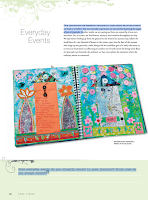.png)
.png)















.png)
.png)
.png)
.png)
.png)
.png)
.png)
.png)
.png)

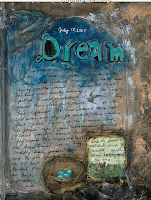.png)
.png)
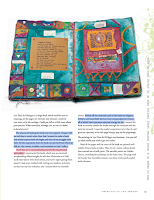.png)
.png)
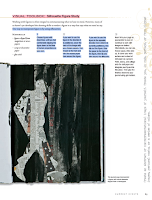.png)
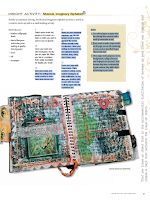.png)
.png)
.png)